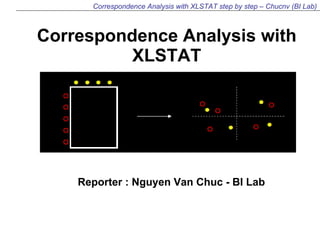
Correspondence analysis(step by step)
- 1. Correspondence Analysis with XLSTAT Reporter : Nguyen Van Chuc - BI Lab
- 3. Two stages and three steps of each stage in CA process
- 6. How to run Correspondence Analysis with XLSTAT Now, we use XLSTAT Tool to describe how to run CA and explain the result base on an example step by step. In order to illustrate the interpretation of output from correspondence analysis, the following example is worked through in detail.
- 7. The following contingency table showing the frequency of usage of four brands of toothpaste in three geographic regions among a random sample of 120 users Table 1. Brand by Region Contingency table
- 8. Analyzing Data – Correspondence Analysis CA
- 9. Table 2. Row and Column profiles
- 10. 1.Significance of Dependencies The first step in the interpretation of correspondence analysis is to establish whether there is a significance dependency between rows and columns
- 11. 2.Dimensionality of the solution The second step in interpretation is to determine the appropriate number of dimension to use to describe the points. This is achieved by examining eigenvalue and percentage of inertia In this example, two dimensions explain 100% of inertia since two dimensions are sufficient to explain the total inertia
- 12. 2.Dimensionality of the solution In this example two dimensions are sufficient to explain the total inertia
- 13. 3. Interpreting the axes The axes are interpreted by way of the contribution that each element (in this case each Brand) makes towards the total inertia accounted for by the axis. In this example there are 4 brands, thus, any distribution greater than 100/4 = 25% would represent significance greater than what would be expected in the case of a purely random distribution of Brands over axes. In this case, brand A meets (satisfies) this criterion and determines the first axis and Brand B determines the second axis
- 14. 3. Interpreting the axes Likewise, for columns, Region 3 determines the first axis and the second axis is determined by Region 2 and Region 1 (Because of the contributions > 100/3=33.3%) Note that, Brand A determines the first axis(F1) and F1 is determined by Region 3, thus it is obvious to understand that Brand A strongly associated with region 3 (see symmetric plot).
- 15. 4. Graphical Representation of a contingency table Brands C and D are positioned relatively closely indicates a similarity in their regional usage profiles (60%, 75% respectively) and Brand A is positioned relatively far away from Brands C and D indicates that Brand A has a very different regional usage profile from Brands C and D Categories with similar distributions will be represented as points that are close in space, and categories that have very dissimilar distributions will be positioned far apart If a profile is very different from the average profile (centroid) , then the point will lie far from the origin , whereas, profile that are close to the average will be represented by points close to the centroid. If all the categories have equal profiles then all the points will fall in the centroid.
- 16. 4. Graphical Representation of a contingency table The proximity of Brand A to the Region 3 indicates that Brand A is strongly associated with Region 3 which is clearly because profile presented in table 2 with 75 % brand A users reside in region 3. Likewise, the proximity of brand B with region 2 and Brands C and D with region 1 indicate that the higher frequency of usage of those brands in those regions. The positions of the points in the map tell you something about similarities between the rows, similarities between the columns and the association between rows and columns
- 17. 4. Graphical Representation of a contingency table In the Asymmetric row plot map, rows are plotted base on principal coordinates and columns are plotted base on standard coordinates.
- 18. 4. The quality of representation The higher of total of two (or first n dimensions) the higher quality of the representation. In this example, two axes explain 100% of the inertia (The first dimension explains 61.8% of inertia and the second dimension explains 38.2% of the inertia).
- 19. 4. The quality of representation The quality of representation is easily calculated from the correlations or squared correlations given in the output. The squared correlation presented for any column measures the degree of association between that column and a particular axis. So, for instance, the squared correlation between Brand A and the first and second axes is 0.986 and 0.014 respectively. This implies that Brand A are strongly associated with the first axis (Region 3) but only weakly associated with the second axis (Region 1 and Region 2).
